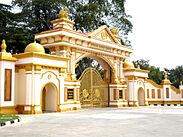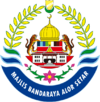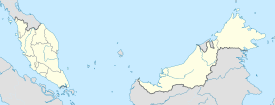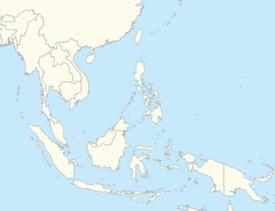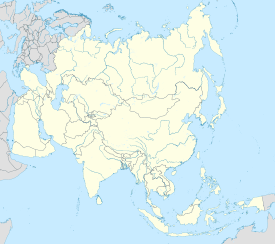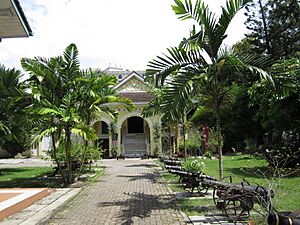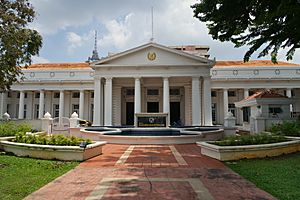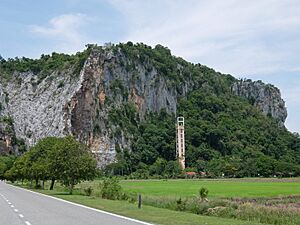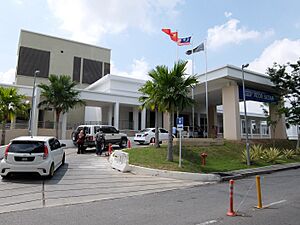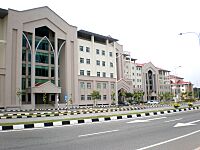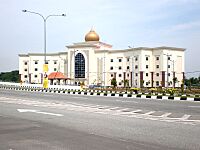Alor Setar facts for kids
Quick facts for kids
Alor Setar
Loqstaq
|
|||
|---|---|---|---|
|
State capital city and district capital
|
|||
| City of Alor Setar Bandaraya Alor Setar |
|||
| Other transcription(s) | |||
| • Jawi | الور ستار | ||
| • Chinese | 亚罗士打 (Simplified) 亞羅士打 (Traditional) Yàluó Shìdǎ (Hanyu Pinyin) |
||
| • Tamil | அலோர் சேதார் Alōr Cētār (Transliteration) |
||
| • Thai | อาโลร์เซอตาร์, เมืองไทร Mueang Sai | ||
|
From top, left to right: City skyline, Alor Setar Tower, Balai Nobat (Nobat Tower), the Anak Bukit Palace, Kedah State Art Gallery, Pekan Rabu, Zahir Mosque, Kuala Kedah Marina
|
|||
|
|||
| Motto(s):
Bandaraya Berdayahuni 2035
"Livable City by 2035" |
|||
| Country | |||
| State | |||
| District | Kota Setar Pokok Sena |
||
| Establishment | 1735 | ||
| Establishment of the local government | 1905 | ||
| Establishment of the town board | 1958 | ||
| Establishment of the town council | 1970 | ||
| Establishment of the local government district council | 1976 | ||
| Municipality status | 1 February 1978 | ||
| City status | 21 December 2003 | ||
| Founded by | Sultan Muhammad Jiwa Zainal Adilin II | ||
| Government | |||
| • Type | City council | ||
| • Body | Alor Setar City Council | ||
| Area | |||
| • State capital city and district capital | 424 km2 (257.14 sq mi) | ||
| Elevation | 57 m (187 ft) | ||
| Highest elevation
(Mount Keriang)
|
99 m (325 ft) | ||
| Population
(2020)
|
|||
| • State capital city and district capital | 417,800 | ||
| • Density | 982.00/km2 (2,543.4/sq mi) | ||
| • Metro | 839,400 | ||
| Time zone | UTC+8 (MST) | ||
| • Summer (DST) | Not observed | ||
| Postal code |
05xxx
|
||
| International dialling code prefix | +6047 (landline only) | ||
Alor Setar is the capital city of Kedah, a state in Malaysia. It is the second-largest city in Kedah. It is also an important city on the west coast of Peninsular Malaysia. Alor Setar is home to the Alor Setar Tower, which is the third-tallest tower in Malaysia.
This city is a major travel spot in the northern Malay Peninsula. It is on the main route from Malaysia to Thailand. Alor Setar is located along Malaysia's longest highway. It is about 430 km (267 miles) from Kuala Lumpur. It is also about 79 km (49 miles) north of George Town, Penang. You can easily reach Alor Setar from Thailand. It is about 51.8 km (32.2 miles) from Sadao and 106 km (66 miles) from Hat Yai.
The city was first called Kota Setar in 1785. Because it has been Kedah's capital for a long time, Alor Setar is a key cultural center for the Kedahan Malays. It also played a big part in early transportation in British Malaya. Its railway station opened in 1915. The airport followed in 1929.
Alor Setar is where the main state government offices are located. It is also the administrative centre for the Kota Setar District. The city covers an area of about 666 square kilometers (257 square miles). More than 400,000 people live here, based on the 2020 census. The city is managed by the Alor Setar City Council.
Two important prime ministers of Malaysia were born here. They are Tunku Abdul Rahman, Malaysia's first prime minister (1957-1970), and Mahathir Mohamad, who served the longest (1981-2003 and 2018-2020).
Contents
What Does "Alor Setar" Mean?
The name "Alor Setar" comes from two Malay words. Alor means "small stream". Setar refers to the Bouea macrophylla tree. This tree is also known as the marian plum or plum mango. It is related to the mango fruit.
The city's name was changed to Alor Star on December 21, 2003. This was when it officially became a city. However, the original name, Alor Setar, was brought back on January 15, 2009.
A Look Back: Alor Setar's History
How Alor Setar Began
Alor Setar was founded on December 31, 1735. It was started by Sultan Muhammad Jiwa Zainal Adilin II, Kedah's 19th ruler. This was the eighth capital city for Kedah since the Sultanate began in 1136. Before this, the capitals were in places like Kota Bukit Meriam and Kota Sungai Emas.
The area was originally a small village. But the Sultan saw it as a great location. It was green and located where two parts of the Kedah River met. The Sultan and his ministers agreed to build a new town. They called it "Kota Setar," named after the Bouea macrophylla trees found there.
Times of Trouble
A new government building was built in the town. The Sultan lived in Istana Kota Setar, his palace. But the capital faced a big attack in 1770. The Bugis army, led by Raja Haji, destroyed the Royal Palace and the Grand Hall. In 1771, the British, with Francis Light, made a deal with Sultan Abdullah Mukaram Shah. This helped stop the Bugis' power in Kedah.
In 1805, during a special ceremony for Ahmad Tajuddin Halim Shah II of Kedah, Siamese forces took over the capital. The Sultan had to leave and went to Penang, then Malacca. The town was quiet for 20 years. The Sultan returned in 1842. The capital was moved to Kota Kuala Muda for a short time before coming back to Kota Setar.
Growing and Recovering
In 1883, an Englishman named James F. Agustin visited the area. He traveled inland from Kuala Sungai Kedah (now Kuala Kedah). He saw many Malay villages along the Kedah River.
When he arrived in Kampung Kota Setar, he met local Malays. They invited him to the Sultan's palace. Agustin was impressed by the palace and the beautiful trees around it. The Sultan welcomed him, and they traded goods.
Agustin's visit helped increase trade between the area and other powerful trading centers. The city attracted traders from Britain, India, and China. Local and regional merchants also came. The small settlement grew into a busy town. It was ready for more people, businesses, and government activities. The British were especially interested in Kota Setar's potential.
Over time, Kota Setar became a hub for business, transport, and communication in Kedah. Its name was changed from Kota Setar to Alor Setar. This name reflected its location near a small stream ("Alor" in Malay). Malay traders from nearby states often used this stream. However, Kota Setar remained the name of a sub-district within Alor Setar.
The 19th and 20th Centuries
Other important events happened around the early 1900s. Perlis and Setul (now Satun) rejoined Kedah in 1897. Both had been separated from Kedah in 1821. This event took place in Balai Besar. The Crown Prince of Kedah, Tuanku Abdul Aziz, attended. In 1904, the city saw a huge wedding for five of Sultan Abdul Hamid Halim Shah's children. It lasted three months and cost a lot of money.
On July 25, 1905, the Legislative Council of Kedah was formed in Alor Setar. The Crown Prince, Tuanku Abdul Aziz, was its president. After the Anglo-Siamese Treaty of 1909 on July 7, 1909, power was transferred from the Siamese to the British. This happened at Balai Besar on July 15, 1909.
Alor Setar was taken over by the Japanese on December 13, 1945. It was then given to the Siamese until 1946. The handover from the Siamese back to the British happened in Padang Court, Alor Setar, on October 18, 1946.
The town joined the protests against the Malayan Union after the war. About 10,000 people protested against the British plan. Tunku Abdul Rahman and other leaders from UMNO led this protest. The town also hosted the 4th UMNO General Assembly. Here, the first ideas for Malaysia's current Constitution of Malaysia were discussed.
The coronation of Abdul Halim of Kedah, Kedah's 28th Sultan, was held in Balai Besar on February 20, 1959. The city celebrated Sultan Abdul Halim's 25th year as ruler in 1983.
Alor Setar's growth in the 20th century also meant more buildings and people. The city council was upgraded several times. It became the Kota Setar Municipal Council on February 1, 1978. The town celebrated its 250th birthday in 1985. In 2000, the Malaysian Ministry of Housing and Local Government suggested making the town a city.
The 21st Century
Alor Setar officially became a city on December 21, 2003. It was the ninth city in Malaysia to achieve this status. A ceremony was held at Dataran Tunku, Alor Setar. Kedah's Sultan Tuanku Abdul Halim Mu'adzam Shah, his wife, and other important people attended.
During the ceremony, the city was formally renamed "Alor Star." This was the third time its name had changed. But on January 15, 2009, the older, historical spelling "Alor Setar" was brought back as its official name.
How Alor Setar is Governed
Alor Setar is represented by three Members of Parliament. It also has nine members in the Kedah State Legislative Assembly.
| Parliamentary Constituencies | State Constituencies |
|---|---|
| P.008 Pokok Sena | N.09 Bukit Lada, N.4 Pantai Damai, N.10 Bukit Pinang, N.11 Derga |
| P.009 Alor Setar | N.12 Suka Menanti, N.13 Kota Darul Aman, N.14 Alor Mengkudu |
| P.010 Kuala Kedah | N.15 Anak Bukit, N.16 Kubang Rotan, N.17 Pengkalan Kundor |
Alor Setar's Geography and Climate
Where is Alor Setar Located?
Alor Setar is in the northwest part of Peninsular Malaysia. It is near the Malacca Strait, which separates Malaysia from Indonesia. The Kota Setar district includes Alor Setar. It borders the districts of Kubang Pasu, Pokok Sena, and Pendang.
The city covers about 666 square kilometers (257 square miles). This includes the nearby Pokok Sena district. Several important rivers flow through Alor Setar. These include the Kedah, Langgar, and Anak Bukit Rivers. Alor Setar's highest point is Mount Keriang (Gunung Keriang). It is a 217.9-meter (715 feet) high hill. Inside it, you can find limestone caves and geodes with calcite crystals.
What is Alor Setar's Climate Like?
Alor Setar has a tropical monsoon climate. This means it has a very long wet season. Even during the short dry season, there is still some rain. Temperatures stay quite steady all year. High temperatures are around 32 degrees Celsius (90°F). Low temperatures are around 23 degrees Celsius (73°F). Alor Setar gets about 2300 mm (90 inches) of rain each year.
| Climate data for Alor Setar (2016–2023) | |||||||||||||
|---|---|---|---|---|---|---|---|---|---|---|---|---|---|
| Month | Jan | Feb | Mar | Apr | May | Jun | Jul | Aug | Sep | Oct | Nov | Dec | Year |
| Mean daily maximum °C (°F) | 32.6 (90.7) |
34.0 (93.2) |
35.2 (95.4) |
34.1 (93.4) |
33.2 (91.8) |
32.3 (90.1) |
32.1 (89.8) |
31.9 (89.4) |
31.7 (89.1) |
31.9 (89.4) |
31.8 (89.2) |
31.7 (89.1) |
32.7 (90.9) |
| Mean daily minimum °C (°F) | 23.4 (74.1) |
23.2 (73.8) |
23.8 (74.8) |
24.9 (76.8) |
25.1 (77.2) |
24.8 (76.6) |
24.6 (76.3) |
24.4 (75.9) |
24.1 (75.4) |
24.3 (75.7) |
24.2 (75.6) |
23.8 (74.8) |
24.2 (75.6) |
| Average precipitation mm (inches) | 80.7 (3.18) |
52.3 (2.06) |
97.4 (3.83) |
190.3 (7.49) |
285.6 (11.24) |
145.6 (5.73) |
219.1 (8.63) |
265.8 (10.46) |
276.0 (10.87) |
304.5 (11.99) |
233.3 (9.19) |
104.7 (4.12) |
2,255.3 (88.79) |
| Average precipitation days | 6.5 | 3.9 | 7.0 | 13.0 | 16.8 | 11.5 | 13.1 | 14.1 | 17.2 | 18.4 | 14.8 | 9.4 | 145.7 |
| Source 1: Meteomanz | |||||||||||||
| Source 2: World Meteorological Organization (precipitation 1971–2000) | |||||||||||||
Who Lives in Alor Setar?
There isn't a special name for people from Alor Setar. You can just call them "Orang Alor Setar," which means "people from Alor Setar" in Malay.
People and Religions
The information below is from the 2010 census by the Department of Statistics Malaysia.
| Ethnic composition of Alor Setar (2010) | ||||
|---|---|---|---|---|
| Ethnicities / Nationality | Percentage | |||
| Malay | 73.3% | |||
| Chinese | 21.9% | |||
| Indian | 2.3% | |||
| Other Bumiputras | 0.1% | |||
| Others | 0.3% | |||
| Non-Malaysians | 1.8% | |||
In 2010, Alor Setar had 357,176 people. Most of them were Malays, making up 73.3% of the population. Most Malays here are from Kedah. The Chinese community made up 21.9%. Most local Chinese speak Hokkien. There are also smaller groups who speak other Chinese dialects. Indians, mostly Tamils, were 2.3% of the population. Other groups included Bumiputeras and other ethnicities like Siamese. People from other countries made up 1.8%.
Languages Spoken
The main language spoken is the Kedah-Northern Malay dialect. It is used as the common language for communication. However, standard Malay, English, and Manglish (a local version of English) are also widely understood.
The Han Chinese, the second-largest group, mostly speak Hokkien. But many also know Mandarin and Cantonese. Some also speak Hakka or Teochew.
Other languages you might hear in Alor Setar include Tamil, spoken by the Indian community. The Kedah-Siamese community speaks Southern Thai.
Religious Beliefs

Most people in Alor Setar follow Islam. This is linked to the strong Malay/Muslim identity. The city has two main mosques: Masjid Zahir and Masjid Al Bukhary. Zahir Mosque is the state mosque of Kedah. It has a rich royal history. It was built in 1912 and opened in 1915 by Sultan Abdul Hamid Halim Shah. Its design was inspired by the Azizi Mosque in Sumatera. Masjid Al Bukhary, finished in 1999, combines designs from different parts of the Islamic World. There are 69 mosques and many smaller prayer houses (surau) in the city for Muslims.
Buddhism also has many followers, mainly among the Chinese and Siamese communities. Wat Nikrodharam is a main Buddhist temple. Its design shows strong Thai influences with some Chinese touches. It is a peaceful place in the city center. Both Theravada and Mahayana Buddhist traditions are practiced here. The Tou Mu Kung Temple is a Taoist temple. It worships the Empress Registrar of Birth (Dou Mu) and Nine Emperor deities. This temple has both Taoist and Buddhist influences.
Besides Islam and Buddhism, other religions are also practiced. These include Hinduism, Christianity, and Sikhism. There are many places of worship for these communities. For Hindus, the Sri Maha Mariamman Devasthanam Hindu Temple is a main temple. Christians have several churches, like Alor Setar Baptist Church and Church of St. Michael (a Roman Catholic church). Sikhs worship at Gurdwara Sahib Alor Setar.
Alor Setar's Economy

Alor Setar is an important center for business and industry in Kedah. Other important centers are Sungai Petani and Kulim. Many international and national banks have branches here. Several insurance companies also operate in the city.
In the past, farming, especially rice production, was the main part of the economy. But now, the local economy also relies on other industries. These include manufacturing, retail, hotels and tourism, financial services, food processing, and fishing.
The main industrial areas in Alor Setar are Mergong Barrage, Mergong 1 & 2, Tandop, Kristial Light Industrial Park, and 2010 Industrial Park.
Getting Around Alor Setar
The capital of Kedah has good connections to all parts of Peninsular Malaysia by different types of transport.
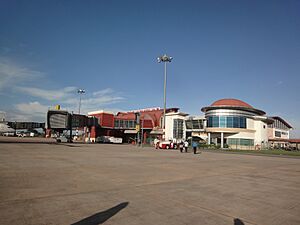
By Land
The North–South Expressway makes it easy to drive to Kedah. This highway goes from Bukit Kayu Hitam (at the Malaysia–Thai border) to Singapore. It takes about 6–7 hours to drive from Kuala Lumpur. It's about a 1.5-hour drive from Penang. You can also reach Songkhla province in Thailand in about an hour from Alor Setar. This is via the Padang Besar–Sadao Highway.
Alor Setar can also be reached from the east coast using the East–West Highway. Towns like Butterworth and Kangar are also accessible from Alor Setar. Car rental services are available.
By Bus
Most bus companies in Peninsular Malaysia offer air-conditioned express bus services. You can buy tickets at bus terminals or ticket offices. All buses arriving in Alor Setar stop at Shahab Perdana Terminal Bus. From this terminal, you can travel to other towns, including those in Thailand. Local bus services are also available, serving almost all towns in Kedah.
By Train
Train services are provided by Keretapi Tanah Melayu Berhad (KTMB). They offer ETS services. Trains run between Alor Setar and Kuala Lumpur, Butterworth, Padang Besar, and Gemas. The city has two railway stations: Alor Setar railway station and Anak Bukit railway station. You can get tickets at the station or book online.
By Air
The Sultan Abdul Halim Airport (Alor Setar Airport, IATA code: AOR) was built in 1929. It is the second oldest airport in Malaysia. It is located at Kepala Batas, about 15 km (9.3 miles) north of the city. It mainly handles domestic flights. Malaysia Airlines, Firefly, Malindo Air, and AirAsia have many daily flights connecting Alor Setar to Kuala Lumpur. Since October 1, 2018, the airport also has flights to Johor Bahru four times a week. Since September 9, 2013, Malaysian Airline System has offered seasonal international direct flights to Madinah and Jeddah. These flights are for Hajj pilgrims.
By Sea
Passenger ferry services to and from Langkawi are available at Jeti Kuala Kedah, Alor Setar. The jetty is about 15 km (9.3 miles) west of the city. Travelers can take a bus, taxi, or e-hailing service from the city center to the jetty.
Other Important Services
City Administration
According to the Ninth Malaysia Plan, Bandar Muadzam Shah in Anak Bukit will become the new Administrative Centre by 2010. This means it will take over some administrative roles from Alor Setar city. Bandar Muadzam Shah is getting many new buildings. These include a new police station, a new National Registration Department office, and new state government buildings.
The Anak Bukit railway station was built in 2015. This helps connect the administrative center to Malaysia's train network.
Courts and Police
The Alor Setar Court Complex is on Jalan Suka Menanti. It has the High Court, Magistrates' court, and Sessions Court. For Islamic family matters, cases are heard in the Syariah Court in Bandar Muadzam Shah.
The Kedah Police Headquarters is on Jalan Stadium. The Kota Setar district police headquarters is on Jalan Raja. There are also several police stations in Kuala Kedah, Anak Bukit, Kepala Batas, and Alor Jaggus.
Sports Places
There are several large sports venues in the city. The biggest is the Darul Aman Stadium. It opened in 1962 and can hold 30,000 people. The stadium hosted the 2006 Sukma Games. It was also one of the places for the 1997 FIFA World Youth Championship.
Other major sports venues include Sultan Abdul Halim Stadium, Kedah Aquatic Centre, Muadzam Shah Complex, and MBAS Swimming Pool Complex.
Parks and Fun Places
The city council maintains several public parks. One of the most famous is Taman Jubli Perak (Silver Jubilee Park). This park has two old traditional Malay Houses that have been restored. They are called Rumah Seri Banai and Rumah Tok Su. These houses are in the Heritage Village (Kampung Warisan). The Heritage Village is next to the Warrior Square (Dataran Pahlawan).
Other parks in the city include Taman Jubli Emas. It is known for its Tengkolok monument. This monument was built in 2008 for the Golden jubilee celebration of Sultan Abdul Halim. There is also Dataran Tanjung Chali (Cape Chali Square) with its lighthouse. Taman Persisiran Sungai Kedah is where annual water sports events are held. Other parks are Taman Rekreasi Medan Peremba and Taman Rekreasi Medan Merdeka.
Healthcare
The city has one public hospital, two private hospitals, and many public health clinics.
Sultanah Bahiyah Hospital opened in 2007. It replaced the old Alor Setar Hospital. It is the largest and main medical center in Kedah, with 1040 beds. It is an important hospital in northern Kedah. It also serves as a main referral hospital for many other clinics and hospitals in the area.
Education
There are many government schools in the city. They are managed by the Kota Setar District Education Office. Some well-known schools include Sekolah Menengah Kebangsaan Sultanah Asma, Kolej Sultan Abdul Hamid, Keat Hwa Secondary School, and Sekolah Menengah Teknik Alor Setar.
Alor Setar is also home to several colleges and universities. It has the main campuses for two universities: Sultan Abdul Halim Mu'adzam Shah International Islamic University (UniSHAMS) and Albukhary International University (AIU). AIU offers scholarships to students from around the world. Other colleges include Kolej Poly-Tech MARA, Royal Air Force College, and Alor Setar Nursing College.
Alor Setar is home to the Kedah State Library. This is the main public library for Kedah. It is also the headquarters for the Kedah Public Library Corporation.
Historical & Cultural Places to Visit
- Balai Besar - This building was originally a grand audience hall. It was part of the Kota Setar Palace complex. The first building was built in 1735 by Sultan Muhammad Jiwa Zainal Adilin II, Kedah's 19th Sultan. It was made of wood. Two Kedah sultans were officially crowned here: Sultan Ahmad Tajuddin Halim Shah II in 1805, and Sultan Abdul Halim in 1959.
- Balai Nobat - This 18-meter (59-foot) tall tower has three levels and eight sides. Its only purpose is to hold the royal musical instruments. These include the serunai (wooden flute), nafiri, gendang (drum), and nobat (gong). The first Balai Nobat was made of wood. It was already built when Alor Setar was founded in 1735. It has been rebuilt twice. The most recent one, from 1906, is made of concrete and metal with a dome.
- Istana Anak Bukit - Anak Bukit is the birthplace and royal palace of Sultan Tuanku Abdul Halim Muadzam Shah. It is also the palace of the current ruler, Sultan Sallehuddin. The Sungai Anak Bukit river flows behind the palace. It connects to the Kedah River and Kuala Kedah. Since 2008, this palace has been used for royal ceremonies. It replaced the old Balai Besar. Sultan Sallehuddin was officially crowned here.
- Kedah Royal Mausoleum - This is where members of the Kedah royal family are buried. It is located in Langgar, close to the city center.
- Kota Kuala Kedah - Kota Kuala Kedah is what remains of a fort on the bank of the Kedah River. For centuries, this fort protected the Kuala Kedah Kingdom from attacks by sea. The fort was first built to defend against the Portuguese. It also stood strong against attacks from the Achenese from Sumatra and the Bugis. The fort was rebuilt between 1771 and 1780. A museum and a lighthouse are also found inside the fort area.
- Wan Mat Saman Canal - This is the longest aqueduct (water channel) in Malaysia. It connects the Kedah River in Alor Setar to Gurun in the south. It was built to help increase rice production in the state.
- Pekan Rabu - Pekan Rabu is near the city's government offices. Its name means "Wednesday Market," but it is open all week. It sells many kinds of handicrafts. It is a popular place for both tourists and local people.
- Rumah Tok Su & Rumah Sri Banai - These are two traditional Kedahan Malay houses that have been restored. You can find them in the Heritage Village (Perkampungan Warisan) at Taman Jubli Perak.
- Pekan Cina & Pekan Melayu - These mean "Chinatown" and "Malaytown." They are the old parts of Alor Setar where old shop houses are still used.
- Istana Sepachendera - The Sepachendera Palace was built in 1882 for Che Sepachendera, Sultan Abdul Hamid Halim Shah's first wife. Since Che Sepachendera was from Siam, you can see Siamese architecture styles in the building. The palace grounds are currently empty, but there are plans to restore it and turn it into a museum.
Museums and Art Galleries
- Kedah State Museum (Malay: Muzium Negeri Kedah) - This museum has a large collection of Kedah's history, culture, and royal items. It includes old Chinese porcelain and items from archaeological digs in Bujang Valley. It also has a 'gold tree' (pokok bunga emas) that was given as a tribute to the Thais. The museum is also a research center for Kedah's cultural history. Before the current building was built in 1936, some items were shown at the Balai Besar. The museum officially opened on February 3, 1957.
- National Science Centre Northern Region Branch (Malay: Pusat Sains Negara Cawangan Wilayah Utara) - This science center is located at Gunung Keriang. It is next to the Alor Setar Aquatic Centre and Paddy Museum. It is the first science center built in northern Malaysia.
- Paddy Museum (Malay: Muzium Padi) - This is the first paddy (rice) museum in Malaysia. It is the fourth in the world, after Japan, Germany, and the Philippines. The museum shows how rice is grown in Malaysia. It also displays the tools and equipment used. Murals by 60 artists from North Korea are also featured.
- Kedah State Art Gallery (Malay: Balai Seni Negeri Kedah) - This gallery was set up to encourage interest in art in Kedah. It has paintings, photographs, musical instruments, and handicrafts.
- Sultan Abdul Halim Mu'adzam Shah Gallery (Malay: Galeri Sultan Abdul Halim Mu'adzam Shah) - This building used to be the Alor Setar High Court. The court moved to a new complex in 2005. This building is located near the Balai Nobat.
- Kedah Royal Museum (Malay: Muzium Diraja Kedah) - This museum was once part of the Kota Setar palace. It was rebuilt after attacks by the Bugis (1770) and Siamese (1821). The current building was finished during the time of Sultan Ahmad Tajuddin Mukarram Shah. He once lived here with his queen. This palace is also called the "Pelamin Palace." This is because it was made bigger for the grand wedding of Sultan Abdul Hamid Halim Shah's five children in 1904. After 1941, the palace was used as a school and offices. On July 25, 1983, it became the Kedah Royal Museum.
- Alor Setar Tower (Malay: Menara Alor Setar) - This 165.5-meter (543-foot) tall tower is in the center of Alor Setar. It is a modern landmark that shows how much Kedah has developed. It is used for telecommunications and is also a tourist attraction. You can get a great view of the city from the top.
- Mahathir Birth House (Malay: Rumah Kelahiran Mahathir) - This is the birthplace of Tun Dr Mahathir. He was Malaysia's fourth and seventh Prime Minister of Malaysia. The National Archives restored this house in 1992. It is now a historic building.
- Independence House (Malay: Rumah Merdeka) - This is another historic building. It holds a collection and memorial for Tunku Abdul Rahman, Malaysia's first Prime Minister of Malaysia. The national archives own it.
Famous People from Alor Setar
Arts
- Singers and Actors: Yunalis Zarai, Shanon Shah
- Actors: Azean Irdawaty, Bront Palarae, Angelica Lee, Farid Kamil, Rozita Che Wan, Jit Murad
- Writers and Arts: Dato' Abdullah Hussain, Dato' Shahnon Ahmad
Sports
- Badminton: Tan Boon Heong, Lee Zii Jia
- Football: Mohd Helmi Eliza Elias, Mohd Khyril Muhymeen Zambri
- Team manager: Dato' Paduka Ahmad Basri Akil
- Football manager: Tan Cheng Hoe
Businessmen
- Tan Sri Syed Mokhtar Al-Bukhary
See also
 In Spanish: Alor Setar para niños
In Spanish: Alor Setar para niños





